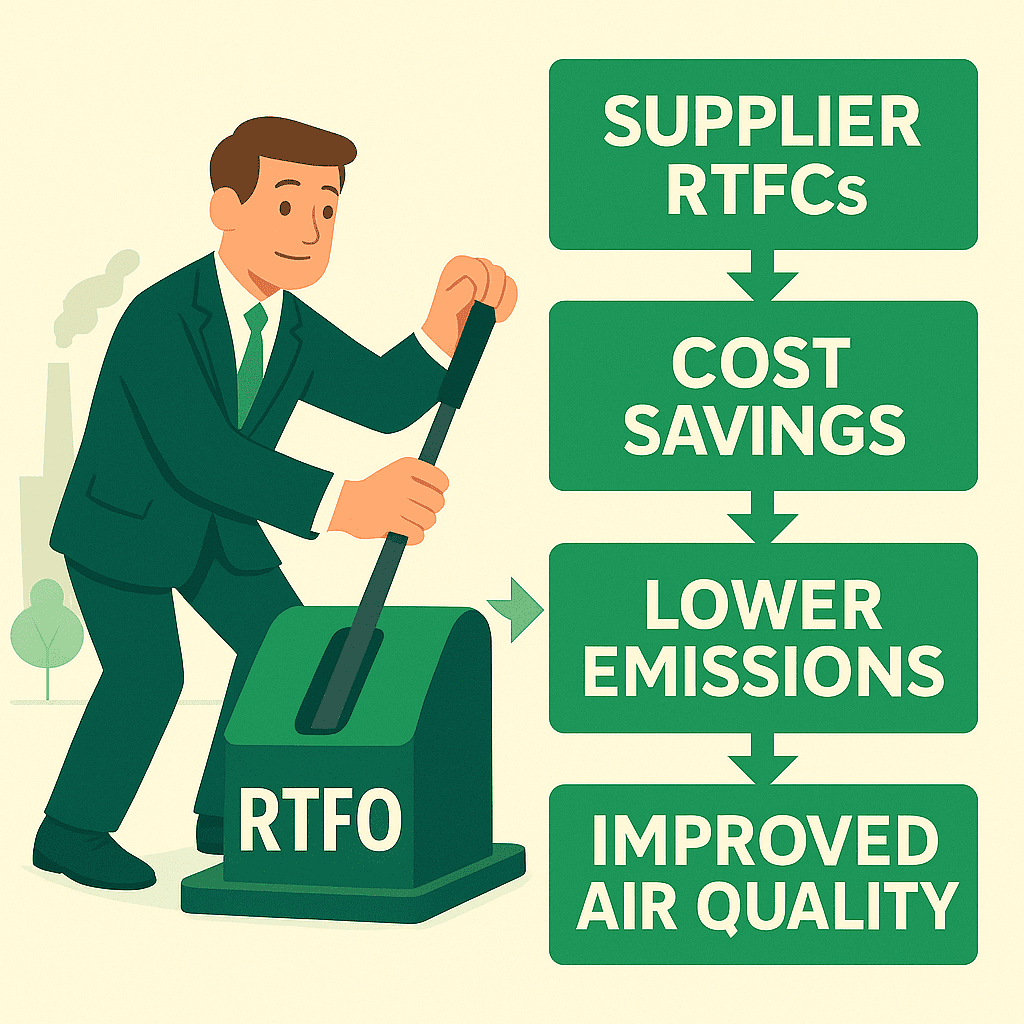What is the RTFO and How Does It Work?
In this article, we explain what the Renewable Transport Fuel Obligation (RTFO) is, how it works, and why it matters to diesel buyers in the public sector.
The Renewable Transport Fuel Obligation (RTFO) is a UK government policy that mandates fuel suppliers to include a growing percentage of renewable fuels—such as HVO (Hydrotreated Vegetable Oil)—in their supply mix. Introduced to reduce greenhouse gas (GHG) emissions from the transport sector, the RTFO applies to companies supplying more than 450,000 litres of fuel annually for use in road transport.
While the RTFO directly affects fuel suppliers, it has indirect consequences for fleet operators, particularly those in local councils, emergency services, and public transport. By understanding how the RTFO works, fleet managers and procurement teams can make more informed decisions and potentially negotiate better pricing or sustainability terms with their existing fuel suppliers.
Key Benefits of switching to HVO fuel

Drop-in compatible
No need for engine modifications or infrastructure changes.

Up to 90% CO₂ reduction
One of the most sustainable fuels available.

Meets ISCC and Zemo RFAS standards
Ensures full compliance with UK regulations.

Scalable and available now
No waiting for EV or hydrogen infrastructure development.
What the RTFO Means for Your Diesel Supplier
To understand how the RTFO works in practice, it’s essential to explain what Renewable Transport Fuel Certificates (RTFCs) are and how the mechanism functions.
RTFCs are the compliance currency of the RTFO. For every litre (or energy-equivalent) of qualifying renewable fuel a supplier places on the market, they earn one RTFC. Fuels made from certain waste and residue feedstocks—like used cooking oil or animal fats—qualify for double certificates due to their greater greenhouse gas savings.
At the end of each compliance year, suppliers must redeem a number of RTFCs equivalent to their obligation. If they fall short, they must pay a “buy-out” fee for the missing certificates. These fees are currently £0.50 per litre for standard renewable fuel and £0.80 per litre for development fuel shortfalls. These rates have applied since 2022 and are confirmed in the UK Department for Transport’s RTFO Compliance Guidance for 2025.
This creates a powerful financial incentive: it’s cheaper for suppliers to supply fuels like HVO—which generate more RTFCs—than to buy certificates on the market or pay the penalty.
This certificate trading system is what enables the RTFO to function as a market-based mechanism for reducing carbon in the transport fuel supply.
Your diesel supplier is legally obligated to meet renewable fuel targets set by the RTFO. In 2024, the obligation requires that 15% of all supplied fuel (by energy) comes from verified renewable sources. This will rise to 19.5% by 2030 and over 21% by 2032, including sub-targets for advanced fuels.
The most cost-effective method for suppliers is to blend or sell highly compliant renewable fuels like HVO fuel, especially those derived from waste feedstocks that qualify for double RTFCs.
How fuel suppliers can meet RTFO requirements
1. Supply renewable fuels
If fuel suppliers sell fuels like HVO they can claim double the number of Renewable Transport Fuel Certificates (RTFCs) to help fulfill their annual obligation.
2. Buy RTFCs from other suppliers
Fuel supplier can purchase RTFC’s from other fuel suppliers on the open market to help them meet their obligation. This is driven by supply and demand against the buy out feed and excess RTFC stock available in the open market.
3. Pay a buy-out fee for any shortfall
How This Affects You as a Public Sector Fleet Operator
Although you’re not legally obligated under the RTFO, your diesel supplier is—and this has pricing and strategic implications for you:
Blended diesel costs are increasing
As suppliers are required to include a higher percentage of renewable fuel or pay buy-outs, the cost of standard diesel can increase.
Suppliers benefit from HVO sales
As HVO earns more RTFCs and helps fuel suppliers avoid penalties, fuel companies are increasingly motivated to supply it.
You can negotiate smarter
By demonstrating awareness of the RTFO, you can leverage your supplier’s compliance obligations during procurement discussions.
Using the RTFO to Your Advantage
Here’s how public sector buyers can use the RTFO legislation to their benefit:
- Request RTFO-aligned options: Ask your supplier how much of their diesel supply is RTFO-compliant and whether HVO can be offered as a primary or partial replacement.
- Negotiate better rates on HVO: Since HVO allows suppliers to meet their RTFO obligations more efficiently (especially with waste-based HVO offering double RTFCs), you may be able to negotiate favourable pricing.
- Increase sustainability without capital costs: HVO is a drop-in fuel that requires no engine modifications, offering an immediate carbon reduction strategy while allowing you to claim environmental leadership.
- Avoid future cost escalations: As buy-out prices increase, so will the embedded costs in standard diesel. Transitioning to HVO early can help insulate your fleet from these changes.
Key Facts
- RTFO target in 2024: 15% (by energy)
- Target by 2030: 19.5%
- Buy-out cost per litre (2024): £0.50 (main obligation), £0.80 (development fuels)
- HVO from waste qualifies for double RTFCs, making it a strategic product for suppliers
The Growing Relevance of HVO
To better understand why HVO is such a strategic choice, it’s worth exploring how HVO is made and how it reduces CO₂ emissions. HVO is produced from waste-based feedstocks using hydrotreatment, resulting in a fuel that is chemically similar to fossil diesel but significantly lower in lifecycle emissions.
Its environmental integrity is reinforced through standards such as ISCC certification, which verifies sustainability and traceability throughout the supply chain. In the UK, the Zemo Renewable Fuels Assurance Scheme offers an additional layer of independent assurance for public sector fleets seeking credible renewable fuel solutions.
As outlined in the government’s Transport Decarbonisation Plan, the RTFO will play a crucial role in helping the UK hit its 2050 net-zero targets. Renewable fuels already make up 6.8% of the UK’s transport fuel by volume (DfT, 2023), and this share is growing annually.
HVO is emerging as the most scalable and immediately compatible renewable diesel alternative—particularly for organisations needing reliability, performance, and sustainability without infrastructure change.
“While the RTFO may seem distant from day-to-day operations, its influence on fuel pricing, availability, and supplier incentives makes it highly relevant to public sector fleet operators. By understanding how it works and how it shapes supplier behaviour, you can use the RTFO to:
- Ask the right questions
- Improve your sustainability performance
- Negotiate smarter supply deals
As more public sector fleets make the switch to HVO, awareness of policies like the RTFO will be essential to making timely, informed, and cost-effective decisions.”
Simon Fowler


